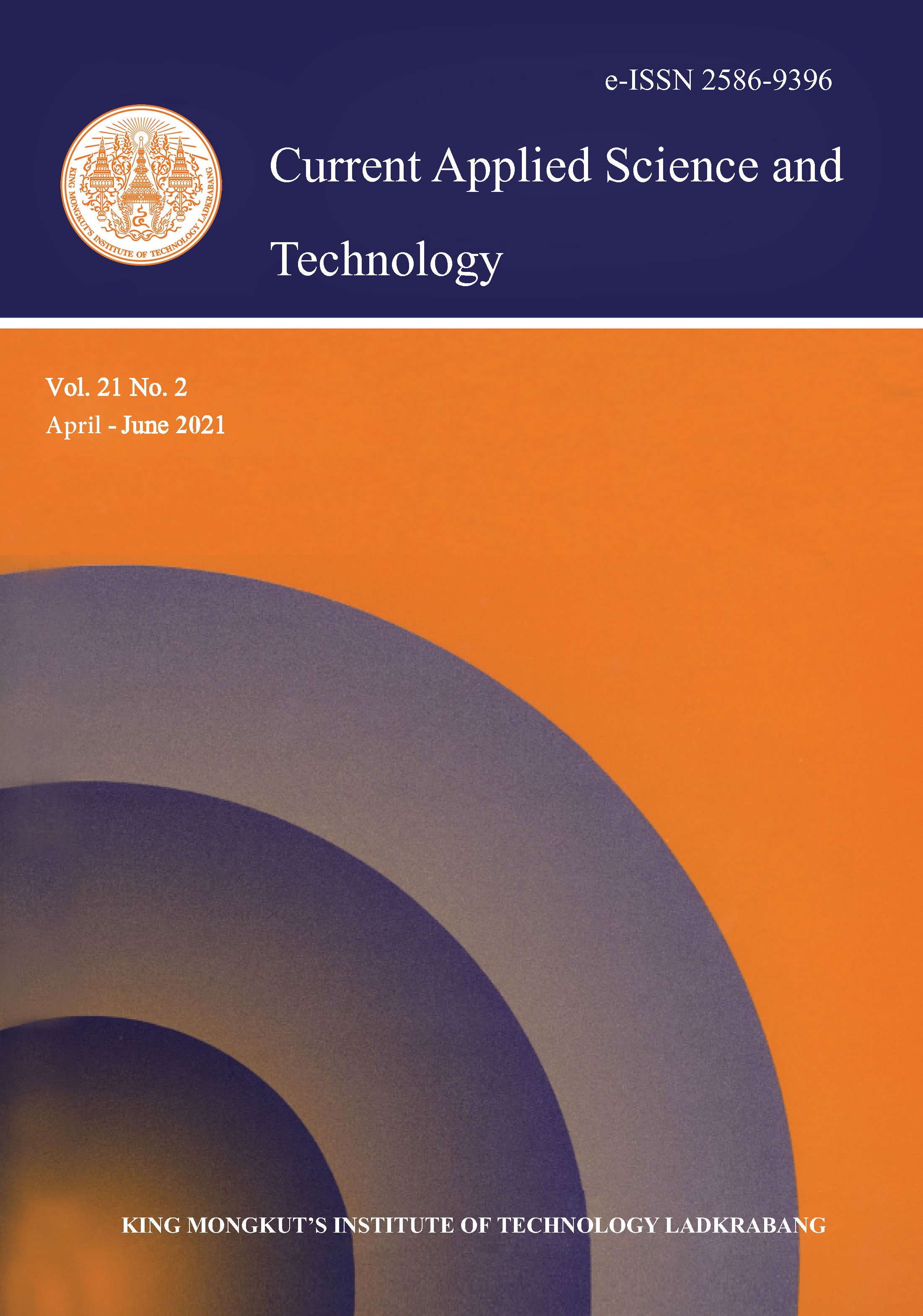Global Stability of the Transmission of Hand-Foot-Mouth Disease According to the Age Structure of the Population
Main Article Content
Abstract
This study investigates a transmission model of Hand-Foot-Mouth disease (HFMD) where the age structure of the population is taken into account. Most infections in Thailand occur among children below the age of 10 years, whose immunity to HFMD is lower than people of age greater than 10 years. Therefore, a mathematical model was developed in which the population was separated into two groups with respect to age: one comprised of children aged less than 10 years, and another comprised of the rest of the population. The reproductive number was obtained by the next-generation matrix approach. Global asymptotical stability of the developed model was assured using Lyapunov’s direct method. The model was validated by showing that the 2D and 3D trajectories of the numerical solutions for the different sub-population groups converged to the endemic equilibrium states when the reproduction number was greater than one, thus supporting the theoretical conclusions. Results show that the time series behaviors of the different normalized populations groups converge to the disease-free state when the values of the parameters are such that the basic reproductive number is 0.591481 (i.e., less than one) and to an endemic state when the values of the parameters are such that and (i.e. greater than one). The results of this study can suggest ways for reducing the outbreak of this disease.
Keywords: Hand-Foot-Mouth Disease (HFMD); SEIR model; mathematical model; stability; age structure
*Corresponding author: Tel.: 662-329-8000 Ext. 6196 Fax: 662-329-8412
E-mail: puntani.po@kmitl.ac.th
Article Details
Copyright Transfer Statement
The copyright of this article is transferred to Current Applied Science and Technology journal with effect if and when the article is accepted for publication. The copyright transfer covers the exclusive right to reproduce and distribute the article, including reprints, translations, photographic reproductions, electronic form (offline, online) or any other reproductions of similar nature.
The author warrants that this contribution is original and that he/she has full power to make this grant. The author signs for and accepts responsibility for releasing this material on behalf of any and all co-authors.
Here is the link for download: Copyright transfer form.pdf
References
Chadsuthi, S. and Wichapeng, S., 2018. The modelling of hand, foot, and mouth disease in contaminated environments in Bangkok, Thailand. Computational and Mathematical Methods in Medicine, 2018(1), 1-8.
Tan, H. and Cao, H., 2018. The dynamics and optimal control of a hand-foot-mouth disease model. Computational and Mathematical Methods in Medicine, 2018(2), 1-11.
Wang, P., Goggins, W.B. and Chan, E.Y.Y., 2016. Hand foot and mouth disease in Hong Kong: A time-series analysis on its relationship with weather. PLOS ONE, 11, 1-12.
Hii, Y.L., Rocklöv, J. and Ng, N., 2011. Short term effects of weather on hand, foot and mouth disease. PLOS ONE, 6, 1-6.
Ma, Y., Liu, M., Hou, Q. and Zhao, J., 2013. Modelling seasonal HFMD with recessive infection in Shangdong, China. Mathematical Biosciences and Engineering, 10(4), 1159-1171.
Wang, J., Xiao, Y. and Cheke, R.A., 2019. Modelling the effects of contaminated environments in mainland China on seasonal HFMD infections and the potential benefit of a pulse vaccination strategy. Discrete and Continuous Dynamical Systems Series B, 24(11), 5849-5870.
Chua, K.B. and Kasri, A.R., 2011. Hand foot and mouth disease due to enterovirus 71 in Malaysia. Virologica Sinica, 26(4), 221-228.
AbuBakar, S., Sam, I.-C., Yusof, J., Lim, M.K., Misbah, S., Mat Rahim, N. and Hooi, P.-S., 2009. Enterovirus 71 outbreak, Brunei. Emerging Infectious Diseases, 15(1), 79-82.
Lin, T.Y., Twu, S.-J., Ho, M.-S., Chang, L.-Y. and Lee, C.-Y., 2003. Enterovirus 71 outbreaks, Taiwan: Occurrence and recognitio. Emerging Infectious Diseases, 9(3), 291-293.
Chan, K.P., Goh, K.T., Chong, C.Y., Teo, E.S., Lau, G. and Ling, A.E., 2003. Epidemic hand, foot and mouth disease caused by human enterovirus 71, Singapore. Emerging Infectious Diseases, 9(1), 78-85.
Department of Disease Control, Ministry of Public Health, 2020. Hand, Foot and Mouth Disease. [online] Available at: https://ddc.moph.go.th/brc/news.php?news=11722&deptcode=brc
Department of Disease Control, Ministry of Public Health, 2018. Hand, Foot and Mouth Disease Situation. [online] Available at: https://ddc.moph.go.th/uploads/files/85e47349de0c253e4b709db62fb 44126.pdf
Department of Disease Control, Ministry of Public Health, 2018. Hand, Foot and Mouth Disease Situation. [online] Available at: https://ddc.moph.go.th/uploads/files/333f54af3da87cf66599 a0def2c30856.pdf
Li, Y., Wang, L., Pang, L. and Sanhong, L., 2016. The data fitting and optimal control of a hand, foot and mouth disease (HFMD) model with stage structure. Applied Mathematics and Computation, 276, 61-74.
Cao, H. and Zhou, Y., 2012. The discrete age-structured SEIT model with application to tuberculosis transmission in China. Mathematical and Computer Modelling, 55, 385-395.
Agusto, F.B., Easley, S., Freeman, K. and Thomas, M., 2016. Mathematical model of three age-structured transmission dynamics of chikungunya virus. Computational and Mathematical Methods in Medicine, 2016, 1-31.
Wang, J., Zhang, R. and Kuniya, T., 2015 . Mathematical analysis for an age-structured HIV infection model with saturation infection rate. Electronic Journal of Differential Equations, 2015(33), 1-19.
Pongsumpun, P. and Wongvanich, N., 2018. Age structural model of the hand foot mouth disease in Thailand. 2018 2nd European Conference on Electrical Engineering and Computer Science, 2018, 134-141.
Pongsumpun, P., Sungchasit, R. and Tang, I.M., 2017. Lyapunov function for a dengue transmission model where two species of mosquitoes are present: Global stability. American Journal of Applied Sciences, 14 (10), 994-1004.
van den Driessche, P. and Watmough, J.A., 2002. Reproduction numbers and sub-threshold endemic equilibrium for compartmental models of disease transmission. Mathematical Biosciences, 180, 29-48.
Heffernan, J.M., Smith, R.J. and Wahl, L.M., 2005. Perspectives on the basic reproduction ratio. Journal of the Royal Society Interface, 2(4), 281-293.
La Salle, J.P., 1976. The Stability of Dynamical Systems. Philadelphia: Society for Industrial and Applied Mathematics.
Chan, S.J., Labadin, J. and Podin, Y., 2017. A dynamic SEIPR model for the spread of hand, foot and mouth disease in Sarawak. Journal of Telecommunication Electronic and Computer Engineering, 9, 125-129.


